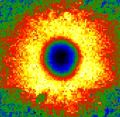Speaker
Description
Perovskites have emerged as promising materials for PV applications due to their high efficiency, low cost, and tuneable bandgap. However, perovskites are susceptible to degradation under ambient conditions, leading to a decrease in solar cell performance over time. Degradation is caused by water vapour and oxygen presence in the ambient environment as well as by illumination. The effect of the degradation on the morphology of the perovskite surface is still not well documented.
This work presents an overview of atomic force microscopy (AFM) studies on prototypical methylammonium lead iodide (MAPI) thin film degradation in the ambient environment. Topographic AFM images were used to track the evolution of surface roughness of perovskite films over time under ambient conditions. The increase in surface roughness of individual grains can be used to monitor perovskite degradation and potentially correlate with the deterioration of optoelectronic properties of the material.
Using topographical AFM measurements, we observed several types of perovskite grains with different crystallographic orientations that were distinguishable on both non-degraded and degraded samples. We discovered that the increase in average roughness of individual grains exposed to the ambient laboratory environment over time is dependent on the initial crystallographic orientation. Grains with certain orientations exhibit faster degradation rates compared to other orientations. These factors contribute to the loss of efficiency and stability in perovskites. We also recreated a comparable experiment in an inert nitrogen atmosphere and proved that the presence of light itself does not cause degradation of MAPI in the absence of humidity and oxygen.
To sum up, we observed inhomogeneity in perovskite degradation in ambient conditions dependent on the individual grains’ orientation. Recommendation of preferable orientation will be done to suppress the degradation process.

